Anyone who has tried building a stockpile of food to get them through emergencies knows that this is an expensive proposition. For that matter, you don’t even need to try building a stockpile to know that; it’s pretty obvious just looking at your receipt from your last trip to the grocery store.
If you ask people what the most expensive food in the grocery store is, they’ll pretty much universally tell you meat. That’s not quite true, as fresh fruit and vegetables are more expensive. But then, we don’t buy fresh fruits and vegetables for our stockpiles, we buy canned. Those cans aren’t all that costly, but then when we go to the meat department, we all want to put our hands on our wallets.
Yet protein is one of the three key macronutrients that we have to have in a survival diet. While carbohydrates and fats provide us with the energy we need, proteins are the essential building blocks for all cells.
Since the body can’t store proteins, if we aren’t eating protein or amino acids (the building blocks of proteins), the body has to cannibalize itself, getting the protein it needs from living cells. Since this process is inefficient, protein deficiency leads to muscle loss, as well as edema (swelling of the ankles, feet and belly).
In order to build an effective survival stockpile, we have to include protein in our diet. The trick is, finding sources of protein we can use, which aren’t going to cost an arm and a leg. Fortunately, there are some tried and true solutions we can use.
Lentils and Other Beans
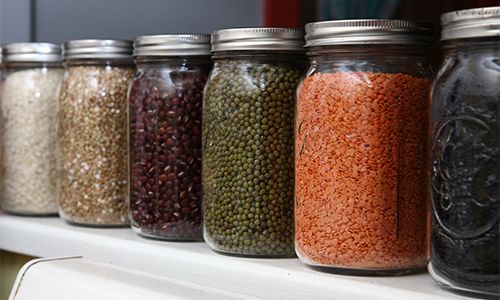 Beans in general are known as protein-rich foods. While they won’t provide the same amount of protein as a nice thick steak will, most beans have about 15 grams of protein per cup. Amongst these, lentils stand out as the highest, with 18 grams of protein per cup. There are many countries in which beans are one of the main protein sources that people eat.
Beans in general are known as protein-rich foods. While they won’t provide the same amount of protein as a nice thick steak will, most beans have about 15 grams of protein per cup. Amongst these, lentils stand out as the highest, with 18 grams of protein per cup. There are many countries in which beans are one of the main protein sources that people eat.
Beans tend to be extremely inexpensive, especially if you buy them dry and in bulk. That makes them ideal for filling those five-gallon buckets with. While they may not be your favorite food to eat, they can be mixed in to soups, casseroles and a variety of other dishes. Dry beans are really cheap, running as low as $0.05 per ounce in bulk.
Related: Bean and Rice Survival Soup; Easy and Adaptable Recipe
Peanut Butter
 The kids’ favorite of peanut butter and jelly sandwiches is actually quite nutritious, mostly because of the peanut butter in them. The bread and jelly are great sources of sugar, fiber and other carbohydrates, while the peanut butter provides protein and fats.
The kids’ favorite of peanut butter and jelly sandwiches is actually quite nutritious, mostly because of the peanut butter in them. The bread and jelly are great sources of sugar, fiber and other carbohydrates, while the peanut butter provides protein and fats.
Two tablespoons of peanut butter has 7 grams of protein and 16 grams of fats. Peanut butter is pretty inexpensive, at $0.11 to $0.15 per ounce.
Compared to the price of buying just nuts, peanut butter is extremely cheap. While adding other nuts to your prepping stockpile can be great source of protein, it’s just about as expensive as buying that steak.
Green Peas
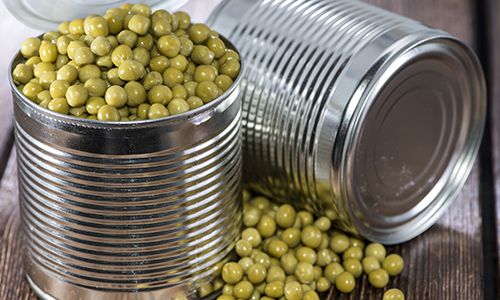 Those little green peas you see on the side of your plate are actually a good protein source, in disguise. Peas actually have 9 grams of protein per cup, making them one of the most protein-rich vegetables around. They’re also rather inexpensive, with cans ranging from $0.60 to $1.20, which works out to as little as $0.06 per ounce.
Those little green peas you see on the side of your plate are actually a good protein source, in disguise. Peas actually have 9 grams of protein per cup, making them one of the most protein-rich vegetables around. They’re also rather inexpensive, with cans ranging from $0.60 to $1.20, which works out to as little as $0.06 per ounce.
You can buy dried peas as well, or at least split peas, but with how well canned foods last, I’m not sure why anyone would want to, unless they’re planning on making split pea soup.
Amaranth and Quinoa
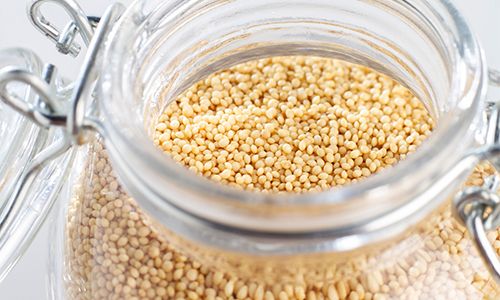 These two grains have become more popular for side dishes in recent years, perhaps as a fad, with them being referred to as “ancient grains.” Unlike other grains, these do not grow from grasses, so are referred to as “pseudocereals” rather than cereals.
These two grains have become more popular for side dishes in recent years, perhaps as a fad, with them being referred to as “ancient grains.” Unlike other grains, these do not grow from grasses, so are referred to as “pseudocereals” rather than cereals.
Nevertheless, they both provide 8 to 9 grams of protein per cup. In addition, they are great sources for complex carbs and fiber, like other grains.
Amaranth and quinoa are especially interesting as plants or grains, as they contains all nine of the essential amino acids. Not many plants do that.
Soybeans
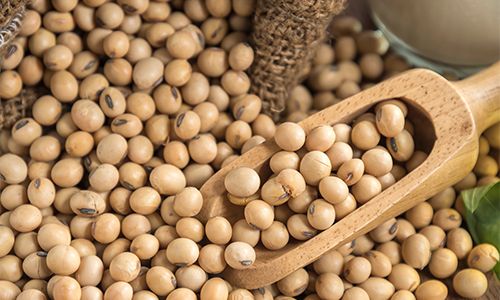 Soybeans are packed with protein, to the tune of 68g per cup. That puts them up in the same range as meats, which might explain the existence of tofu. It certainly can’t be for the taste.
Soybeans are packed with protein, to the tune of 68g per cup. That puts them up in the same range as meats, which might explain the existence of tofu. It certainly can’t be for the taste.
The problem here is finding soybeans, as your local grocery store probably isn’t going to carry them. You’ll have to go to a health food store somewhere, which makes the idea of them being inexpensive something that’s probably a bit iffy.
Nevertheless, if you can find them cheap, or even products made with soybeans, you’ve got a good protein source.
Wild Rice
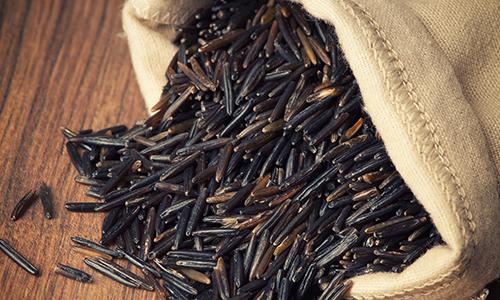 While no rice product is a powerhouse of protein, wild rice contains roughly 1.5 times as much as other types of long-grain rice, like brown rice. So if you’re going to stockpile rice anyway, you’re better off with wild rice, at least from the protein point of view.
While no rice product is a powerhouse of protein, wild rice contains roughly 1.5 times as much as other types of long-grain rice, like brown rice. So if you’re going to stockpile rice anyway, you’re better off with wild rice, at least from the protein point of view.
The problem is finding wild rice at a reasonable price. Most rice consumed in this country isn’t wild rice, not even the brown rice that many people confuse with wild rice. If you buy the boxed version in the grocery store, it will run roughly $0.90 per ounce, which is not bargain. Health food stores are even worse.
However, you can often find it bagged in oriental grocery stores for much less than that.
Oatmeal
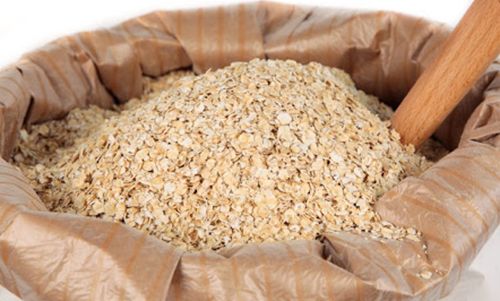 You’ve probably already included oatmeal in your prepping stockpile, which is good, as it provides 6 grams of protein per cup. Granted, that’s not a huge amount, but it is better than most other grains. It’s also great for keeping your cholesterol down and helping your heart.
You’ve probably already included oatmeal in your prepping stockpile, which is good, as it provides 6 grams of protein per cup. Granted, that’s not a huge amount, but it is better than most other grains. It’s also great for keeping your cholesterol down and helping your heart.
Oatmeal also fits our criteria of being an inexpensive food, running around $0.07 to $0.11 per ounce, if you buy the larger packages, rather than the individual servings. In bulk, it tends to run about $0.08 per ounce. But the nice thing about buying it in bulk, is that it’s easier to repackage it in five-gallon buckets that way.
Related: How to Use Avocado Seeds to Lower Blood Pressure and Cholesterol
Canned Meats
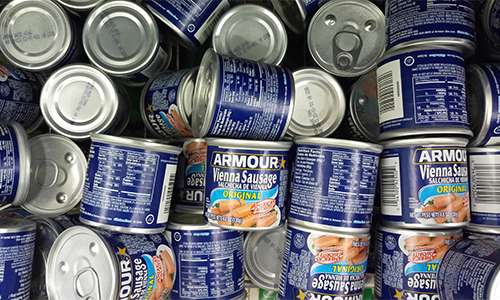 While it might seem like I’m trying to avoid meats on this list, I’m really not. We can’t finish it out, without talking about some of the low-cost canned meat options out there. These may not be your favorites, but their prices make them a really great option for your prepping stockpile.
While it might seem like I’m trying to avoid meats on this list, I’m really not. We can’t finish it out, without talking about some of the low-cost canned meat options out there. These may not be your favorites, but their prices make them a really great option for your prepping stockpile.
- Potted meat – as low as $0.15 per oz.
- Vienna sausages – about $0.13 per oz.
- Lunch loaf (generic Spam) – about $0.16 per oz.
- Canned chunk ham – about $0.25 per oz.
- Canned chicken breast – about $0.25 per oz.
- Deviled Ham – about $0.36 per oz.
- Albacore Tuna – as low as $0.31 per oz.
- Salmon – as low as $0.38 per oz.
- Mackerel – about $0.13 per oz.
- Chicken breast – as low as $0.21 per oz.
Please note that none of those prices are based on catching the items on sale. I’ve gotten canned chicken breast for as little as $1.00 per can, cutting that price in half. That’s how I buy most canned meat, waiting until I catch a sale and then buying a bunch at once.
Of course, canned meats aren’t as tasty as fresh or even frozen meat; but at least it’s meat. When you put it into soup or a casserole, you really can’t tell the difference. So it will satisfy that craving for meat, without having to spend a lot of money.
Just a note: If you’ve been buying fresh fruits and vegetables to can, you’re spending more than you need to. You’re actually better off buying them factory canned. On the other hand, if you’re canning produce you grow, you’re definitely saving yourself some money.
You may also like:
 How To Stockpile Lard, The Calorie Rich Survival Food Of The Great Depression
How To Stockpile Lard, The Calorie Rich Survival Food Of The Great Depression
H2O Dynamo – The Awesome DIY Device That Turns Air Into Fresh Water! (Video)

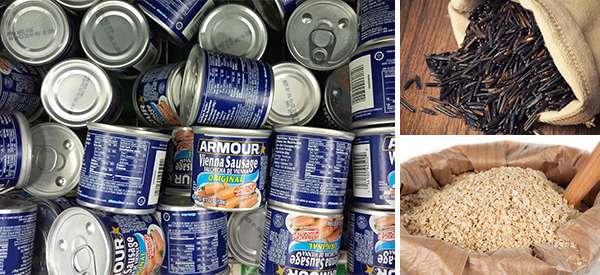













To the best of my knowledge, the Japanese who consume major quantities of soybean products only eat one straight soybean product, fermented soybeans called “natto”.
All the rest of the products are disguised in some form or another. While first generation Japanese immigrants probably prepared natto at home, I doubt that succeeding generations do. All of which leads to the conclusion that I doubt that you can find soybeans per se in Japanese food stores. As for other Asian countries I have no knowledge.
Tofu, covered with sliced green onions and soy sauce poured over it is my favorite way of eating fresh tofu. As a small dish on the side, I find it okay once in a while. Of course, cooked in sukiyaki that is something else. Extra firm tofu in soup is okay too. You can dry tofu and it is very light and doesn’t spoil easily when dried. Blot out all the water in it, cut it in small squares and set it in the sun to dry. You can also dry it in the oven or a dehydrator. As emergency rations, it is light, nutrition dense and easily reconstituted with hot water. Sealed in an airtight package it has an extended shelf life. Can’t say what the shelf life is, but I would think as long as it didn’t show visible signs of mold or other deterioration it would be all right to eat.
As with all food stored a long time, it needs storage at an even temperature, preferably in the dark and a dry storage area. It probably loses food value over extended years of storage.
Most Americans find natto to be an acquired taste. I think if one did not grow up with it, one must compel oneself to eat it. That said, it is very high in food value and you could acquire a worse food habit than natto. I personally have not acquired that taste and my wife who is Japanese does not like natto either. Even among Japanese, not everyone is a fan.
I don’t know if I would be a fan or not, but what about the protein powder mixes on the market? They appear to be high in protein, (60g in Body Fortress, 25g in Pure Protein, and others are around 30g), but I haven’t tried any to see if I could tolerate the taste. I know tastes change with circumstances, but no matter how bad the circumstance, I won’t eat liver. And I don’t mean to offend anybody with my liver aversion. I had to leave the house every time it was being cooked.
P.I.T. I am with you on liver, but I would modify my statement about liver. You just haven’t been hungry enough yet. Ever had liverwurst? Actually it is one of my favorite lunch meats. We had an authentic Jewish deli in town at one time and a Jewish lawyer invite me to lunch there and suggested the chopped chicken liver. Yuk! Just the sound of that makes it unappetizing. He said if I didn’t like it, he would trade with me and he would order what I would have ordered. I agreed. Wow! It was the best liverwurst I had ever had in my life and it made a fan of me for Dave’s chopped chicken liver. Unfortunately, Dave made some business mistakes and had to close his restaurant and nobody absolutely nobody make chopped chicken liver like Dave made.
People who claim to know say that it really is very heavily dependent upon how it is prepared. The way my mother prepared it, it could have easily passed for a half sole for a shoe. It was tough and dry and resisted cutting with even the sharpest knife in the kitchen. Then there is tongue which is another acquired taste which I never acquired.
Many people think tongue is a heavenly dish. My father did and my brother also thinks tongue is heavenly. Okay, if I am really, really hungry and it is tongue or nothing, I will go for it but it is not my idea of a choice cut of meat.
I agree, the palatability of liver (like many other foods but especially “organ” meats) depends quite a bit on how it is prepared: liver is relatively delicate, should never be fried at high heat or for too long, or as you say it will end up like shoe leather. The trick is to gently saute it, whether calves liver or chicken liver, and STOP cooking it as soon as it is done – remove it from the stove even after the stove is turned off, to avoid having it continue to cook in the pan, esp if you are using something like cast iron which retains the heat. I also agree some of the best chopped chicken liver I ever had was from a Jewish deli when I lived in Boston for a while. Every once in a while I try to recreate that dish, but it’s been so long I couldn’t say for sure how well what I make now compares with the deli chicken liver I had in the ’70’s. Maybe I will experiment again, let you know if I come up with a good homemade recipe!
Spice: Chopped liver is the only way I ever found liver tastes like food.
We take liver, simmer it with chopped onion, and when close to done (it should still be pink inside), add 3-5 eggs. They can be broken into it, or whole (for a coarse style), black pepper and garlic. In food processor with one stick butter. Chop or, if you prefer, puree. Eat with corn chips 🙂 We also add roasted chilis, but that’s Mexican style. There are a lot of good deli recipes, and this dish is very easy to make. niio
A vegetarian friend of mine (not only do I have conservative friends, I have friends who don’t eat meat!) prepares Tofu like scrambled eggs, crumbling the crap, I mean the Tofu, into a fry pan and sauteing it with chopped onion, pepper, and mushrooms. That is an insanely healthy meal, probably the perfect meal.
Were Vienna sausages better 50 years ago? they taste terrible these days.
I used to take the little tins of deviled ham, chicken, and beef on hikes, like c rations, don’t know if they still make them.
And Frito Lay Bean Dip used to be made with lard and was the perfect survival food, doesn’t taste near as good now w/o lard.
LCC Now I know why I always manage to drop a few pounds in Japan! I love fish, noodles, but it all has to be cooked. Don’t care much for anything else! If it wasn’t for the great beer and hot dogs, I’d probably starve to death over there. Very surprising how delicious they were too! The beer and hot dogs that is. Someone told me the Germans taught them how to make it all during WW2. No wonder it tasted like I was in Frankurt am and not Nagoya! You can get imported frankfurters from Germany preserved in jars from World Food. Surprisingly not expensive either and they taste great! Not about to buy, make and store stuff no one in the family here will eat or enjoy.
CC: Interesting that you mention losing weight in Japan. I too have had that experience, even though I was pounding beer and snacks every evening with all my wife’s relatives, you know he pours you one, you pour him one and so on around the table and then start over.
In the 19th century when the Emperor Meiji took over leadership of Japan and determined that Japan must absorb western culture in order to compete in the western world one of the things that they did was look all around the world and determined who, in their opinion, had the best in each category.
The Germans had just significantly whipped French forces in the Franco-German war of 1870 and the Japanese, who have historically been a warlike folk, saw the German army principles as the leading military force in the world and hired German army leaders to set up the Japanese army in accordance with Prussian principles of war.
They thought that the Germans were making the best beer at the time and so the German style of beer making was adopted. Beer and sausage go together and my best guess is that along with beer the Japanese adopted German sausage making.
It is interesting to note that the Japanese word for beer when I first went to Japan was “biru”, the Germanic pronunciation. In more recent times the Japanese word for beer has changed to “biya” the Australian pronunciation of the beverage. This, I believe was due to the large influx of Aussies as tourists to Japan, especially for winter skiing which apparently is a non-starter in Aussieland.
If you ask for “biru” today you might get it or you might get “Huh?” if the waitress is young enough.
There really wasn’t;t much communication between the Japanese and the Germans during WWII and the Japanese had beer long before WWII. The rooftop beer gardens became very popular in Japan during the 20s with the western craze that swept over Japan during that decade.
All the “moga” — “modern girls” wore western clothes, smoked and drank in public and looked for a romance wedding, something traditional Japanese women did not do. Even for several decades after WWII, there was a ritual to getting married, even if the couple had already decided that they wanted to marry. They had to get a matchmaker who consulted with the families to see if they supported or opposed the marriage, have the first meeting, have the go-between report back to the families that the marriage was satisfactory to everyone and then announce the engagement.
Actually probably a better system than meeting someone on line who turns out to be Ted Bundy.
Thank you kindly for giving me the inside scoop and a great history lesson to boot!
LCC: Cool to know, thank you. Wannabe Ted Bundy is everywhere. niio
Hi, during the total of 4 years I spent in Japan, I did acquire a taste for natto; so much so that I kept looking for it in the local commissary when I used to live near one. I had forgotten all about it by now (left California in 2015, have not seen it anywhere in the southeast where I live now, but then I hadn’t been specifically looking for a Japanese grocery store.
I think that it may be like varieties of cheese, that is, that the natto can vary in taste depending on the particular variety of fermenting bacteria (yeast?) that is used. Like making your own yogurt, I imagine the results would be best if you start with a known culture to mix in with your soybeans, rather than just letting them ferment and hoping for the best. Or if the known culture is not available, then I guess you would have to just keep on making small batches until you come up with a variety you like, and then keep a sample of that in your fridge like sourdough starter. And like most other fermented products, there is a point at which the natto is best, when you would batch it up and store it in a cool place and eat it as soon as possible; if it sits around for too long, it will go bad. It is normally sold fresh in the refrigerated section of the grocery stores in Japan, like homemade kimchee which is also a fermented product.
I just saw an NHK program on natto and you are right, Spicelady. The culture you use varies the taste according to the young westerner who was doing the program for NHK. The best natto he tasted on the program was by an older Japanese lady who has been making natto for over 60 years. Her secret is to wrap the beans in Japanese rice straw for three days and then eat the natto soon. I don’t know if he was lying or if the natto was really that good, but he almost had an orgasm eating her natto.
According to the program there was a distinctive difference in the taste of each of the locales where he went that produced natto. He wasn’t terribly impressed by the pre-packaged natto sold in the 7-11 konbeni. But that’s not hard to believe, I think most of us are not impressed by the food sold in 7-11. Is it really food?
Don’t forget sardines and Herring. Great taste, healthy (if not from china) and cheap enough.
A can of Sardines is great to slip into your pocket for a day hike, If you are out longer than you planned, you can have a super model breakfast! That’s what they eat! And If you’re out fishing and not catching anything you can still enjoy a fish dinner.
Or use the sardines for bait and perhaps change your fishing luck.
LCC. After they eat all of my bait, I’m not letting them eat my lunch too! Canned Sardines, little cuties that they are, are so softly cooked that as is they would never ever stay on a hook! If you did manage to get a piece on, it would just fall apart as you cast out your line
City: Have you tried bacon rind? It’s a waste product from slab bacon and the butcher might give it to you. Hotdogs work, too 🙂 niio
By the time the stuff comes here, you can have a hard time knowing what it is if it isn’t labeled! Never saw bacon rind in the local market and all the local butcher shops here now are Halal so I don’t think I’ll get any bacon rind in the near future. The good butcher shops closed! No more Karl Ehmer here in the Queens. ScHalle and Weber still in the big city on upper east side, but you’ll risk your life getting up there now.. don’t think Stop n Shop has bacon rind on the delivery website, but I’ll have to check! I know I can get double smoked bacon at triple the price!
CC: Ouch. My sisters up in PA said they’re getting jowl bacon for 99c/lb. End scraps of slab bacon at a Mennonite store that one goes to is $1.49,lb. Here, scrap sells for about 5 bucks a pound, which is weird because they raise a lot of hogs up north in AZ.
Even a little bacon works. Rind is tough and fish can’t tear it up, so people like that. You could watch TK and Mike movies. They give some good advice before they get drunk. On very important thing, never let Mike reload your shells. He tends to forget put in the powder. another one, tho Bigfoot prefers to eat liberals, he does not play well with others, especially when they’re shooting at him. niio
In a nearby town the local grocery store has 10 lb boxes of what they call bacon scraps for just over $10. So close to $1 per lb. Good thick slices most often. Some time odd cuts. I don’t bother buying anything else. I make meal size stacks. Fold in quarters and freeze in sandwich bags. Set in fridge at night to thaw for breakfast.
ClergyLady: And down here bacon is pricey. Yet, AZ is a major pork producer. Had we another acre, buying feeder pigs would be good. the butcher at Rancheros said a quarter a pound to cut and wrap. Problem, city people come here to get out of the heat and when they leave, they abandon dogs and cats. Most dogs are caught and many find new homes. It’s a gross sin because animals belong to God, first. niio
I hate abandoned animals. Here coyotes eat pets that are alone, hungry, or scared. In past years I’ve taken in many. Not able to do that now. Might take in one good dog. Can’t take in just any animals now with rabbits, chickens, ducks, barn cats and my little dog.
Smith’s grocery stores are having case lot sales this week. Cases of chicken breast, tuna, Turkey and beef chili and more. Guess I’ll try to stock up.
LCC: Yes! 🙂
Interesting that peas are also a good source of protein. One of my favorite canned vegetables. The generic canned peas are $.50@ at Wal-Mart if you can still find them.
On my last trip to Walmart, I spotted some canned goods on the shelf that I have never seen at my local supermarket. Maybe you find them in other parts of the country, but they are new to me here. Libby’s brand canned tamales chicken or beef, and canned country gravy with sausage. Picked up a few to try it. Looking for a few things to shake up the old pantry staples! Pea soup however, is the best on a cold winters day! Went to my first Walmart on a business trip down in Tampa. Everyone at the job said it was the place to go to get my glasses fixed! Would not have been able to finish the job without them let alone find my way back home! Well, I thought they were crazy, but they were right on target. Been a customer ever since!
canned country gravy with sausage CC: If you have tried this let me know how you liked it. C-rations had one main meal called “Sausage patties in gravy.” While some found it edible, I never was hungry enough that I found it edible. If heated to the point that all the congealed grease in the can was melted it could be eaten. Unfortunately most of my experience with that particular gustatory treat was limited to barely thawed to pretty cold, complete with congealed grease. Which is close to what I called it, “hockey pucks with congealed grease.”
Given enough time and enough of that particular item, I have no doubt that some palatable meal could be made of it, but just straight out of the can . . .
CC: Wally world is great for most things. They tried the mask-move in one direction only for a few weeks here, but no one bothered with it so they gave up 🙂 One gripe I have is, all too often small cans (coffee, for instance) are usually cheaper per oz than the big cans. Sam Walton would be ashamed of his children. Libby tamales are all right, but nothing beats homemade. Tamales are easy enough to make when camping out. niio
Yes! But I like to pick up the big cans of McDonalds Coffee medium roast! It’s generally half the price being charged in my local Rite Aide, a chain pharmacy around these parts here in the metro area. In any situation, I don’t care what it is, I have to have a coffee!
My Wal-Mart has their generic medium roast ground coffee 3 ful pounds just under $9. It isn’t bad coffee. I have a lot of it put back.
clergyLady: Yeah, but if we can get to Mexico soon, it’s like 90c/kilo for roasted organically raised beans. AKA, they do it the old way and get good production. When the cherries are getting ripe, the men go in, chop down all the brush, let it dry out and crush it for mulch. No chemicals and they don’t usually have an insect problem. niio
CC: Yeah, but I’d have to drive 50 miles one way to get to a Rite Aid. 🙂 If I’m going that far, Mexico is only another 64 miles and coffee beans are pennies on the dollar in Jalisco Gran Mercado. Ground and canned, about 1/3 for the same in the US. Large pineapples (4 lbs!) are like 40c US each and less if buying a case (no need for a license for them as neither is a cash crop in Arizona). Cocoa beans and so on, as well. Do not spend a night in a border town! niio
Canned tomales are ok in a hurry. Warm and serve them liquid and all over rice.
Homemade can’t be beat. Making a few isn’t hard but the last time I made tomallies I made 80 of them. All neatly wrapped and tied with corn husks. That was a job! I make the Pueblo Indian style mostly. Use mutton if I can find it. Thicken with the native white corn grown here. Have to grind it for cooking with. Lots of hot red chili, crushed corriander seeds, and for mine I add some salt. Natives here don’t salt cooking much. They use ground salt from a salt lake south of here. It is kept in a bowl on the table and sprinkled on bite by bite. It tastes like rock salt. My kids would sit watching cartoons eating cold tomalies. With a salt shaker in the other hand. Breakfast! They will still eat them hot or cold.
ClergyLady: How goes it? Getting better? That woman doc in Texas raised h*ll with the liberals over corona. She said she hasn’t lost a patient and all she used to treat them was zinc and an antibiotic, Zithromax. Except for her accent, you listen to her and thing, By God, Texas!
None of us are salt eaters. We can’t handle a lot of it. Might be that’s why we all crave coffee because of the potassium. A very good cook down in Mammoth sells beef tamales, about 2 bucks each, and worth it. Mutton, erk. Goat is good, tho. Tastes like beef 🙂 the Libby tamales have two great things, tho, not a lot of corn in them, and they come in the sauce. niio, be blessed!
Take the natto and cross it with the fungus that grows on corn (think it is called corn smut.) It has been a while since I tried it and to me it was nasty. I’m sure someone has tried it since I saw it in a Howard Taylor comic. I mean they cooked up his made up cheese dish. So I a=m sure someone out there in the interweb world has tried smutto.
Runner: Chefs call it huitlacoche, it’s a very expensive mushroom. It has to be picked and dropped into boiling water. Pregnant women shouldn’t eat it. Very high in protein and not bad eating. Cousns with market gardens have standing orders for it. Never heard of using natto with it. Smutto would probably be a good name for it 🙂 niio
My native amaranth here (2) in fertile soil and with some water grow 5′ – 6′ tall. The 2 make very different leaves. One patterned with a pretty white design and the other plain green. The plain one is better eating. Both grow together and make big seed heads. I can or dry leaves for later use and cook some nearly every day in the fall. I have cut seed heads and shattered them out by hand. Then they must be winnowed. They are tiny black seeds. Not a lot of reward for the stickery work. They aren’t bad added to other grains as they cook. Sometimes I wonder if they are worth it. Maybe if you’re growing more than 2, 12’x24′ garden patches. I have a gallon I collected last year that are still untouched. Husband don’t much care for them. Sine he especially enjoyed the greens ill still let then take over the end of season garden. Seed heads can go to the chickens. They love them.
I believe amaranth leaves are as also a source of some protein.
Thanks for the practical info about Amaranth.
Mike: the silvery-white is called prickly amaranth. Good eating when young! This was once domesticated, the tiny thorns keep off animals and birds from the seeds. niio
This is good to know. What looks so pretty in the garden here now may be a gift to the birds!
I also bought dry peanut butter. It looks like a flour. That was my planned use. Found it at Wal-Mart.
ClergyLady: Peanut butter powder is good! thanks for the heads-up, again 🙂 niio
I would add a relatively new product of several competing companies, tuna in tear-open pouches. On sale, they’re frequently just $1 each, so at 2.5 to 3 ounces, they come in at 33-40 cents an ounce. The ones with ranch, lemon pepper, or deli salad seasoning might not last as well in storage as the plain ones, but they have the big advantage of tasting good on plain crackers or biscuits, which we’re more likely to have around in a crisis than sandwich bread.
They’re also lightweight, since they don’t include the water or oil that would be found in a can, and are easy to open in a hurry. They’re on sale for $1 each at the Kroger here today, so I picked up 10 more of them for my stockpile.
I get these, too, all varieties. There is chicken offered in the same package type.
Soybeans are easily available at any oriental grocery. That is where I purchase mine.
Edamame are soybeans either in the shell or shelled. I like edamame and have them in place of lima beans. Actually, I probably have damaged taste buds because separately, I can’t tell the difference between nuked frozen lima beans and nuked frozen edamame. They both are kind of a starchey green bean in my version of taste.
The soybeans I am envisioning are kind of brownish remotely resembling garbanzos. I have had dried salted soybeans that were considerably better than natto but that still is pretty faint praise.
Chuck, your statementt piques my interest. What do the soybeans look like that are for sale? Do you have any idea how folks prepare them? Are they fresh, dried, canned, how are they sold? I have never seen soybeans in an asian market. Of course, I must admit that I have never looked for them or asked if they were carried, so that proves absolutely nothing. I am amazed. NHK carries two separate cooking programs and I watch them pretty regularly and I have never seen soybeans mentioned as an ingredient in any dish other than natto and, of course, tofu.
Perhaps some other asian country utilizes soybeans in their diet. Salted, boiled edamame in the shell is a favorite bar food in the incredibly numerous small bars in every Japanese city. They go well with either beer or sake. Copious quantities of edamame consumed with equally copious quantities of beer many times will give the consumer impressive quantities of hydrogen sulfide. I think that is the gas that smells like rotten eggs.
In a nearby town the local grocery store has 10 lb boxes of what they call bacon scraps for just over $10. So close to $1 per lb. Good thick slices most often. Some time odd cuts. I don’t bother buying anything else. I make meal size stacks. Fold in quarters and freeze in sandwich bags. Set in fridge at night to thaw for breakfast.
My parents used to like the roasted, salted soybeans for snacks or in homemade trail mix with chunks of dates, dried bananas, and rasins. They bought them in bulk where they lived. I don’t see them around here.
My dad liked boiled cow tongue. Peel the tough layer on it and slice for lunch meat. Shocked… My two older boys loved it. They would trade egg sandwhiches for tongue Sandwhiches. I’m not fond of it.
Well, at the end of the world we will all be happy to have anything to eat, liver, tongue, kidneys, gizzard, tail, ears, snout, chicken legs, I guess also turkey legs and if we really score, ostrich legs. Most of us have never been starvation hungry
LCC: Ostrich, tastes like BEEF. Or, like turkey legs, which taste beefy. I thought you were raised in PA? If it doesn’t try to eat you, it might be food. niio!
I have a family recipe from my great grandmother for something called “Headcheese”. It’s a sliced cold cut, considered a delicacy! Chopped assorted pieces of cooked meats in aspic. Tasted it once way back when. I think it includes the tong. I’d share it with you but darn, I don’t know where I put it. Hard to find a whole fresh cows head in my local Stop n Shop.
CC: This isn’t an old family recipe, I just snagged the first head cheese recipe that I came to. I thought head cheese was hog’s head as opposed to bovine head, although I suppose that too can vary:
“A friend gifted me half a pig’s head so, naturally, I decided to make head cheese. It was already out of the freezer a couple of days when I picked it up so I had to move fast. I started with this recipe but tweaked considerably as I went along. The result is really satisfying—slightly sour (that’s the German influence) with a flavor profile built around savory herbs rather than the usual clove/nutmeg/mace. Makes enough to fill 2 4×8 loaf pans—that’s a lot of head cheese.
Ingredients:
Half a pig’s head, minus tongue and cheek*
1 1/2 T Kosher salt
1 ½ t white pepper
1 ½ t hot red pepper flakes
1 T herbs de Provence or Italian mixed herbs (I didn’t have any h de p on hand for the rub so used a packaged oregano/fennel/marjoram blend)
1 onion, sliced
1 carrot, sliced
1 leek, sliced
3 garlic cloves, crushed
2 cups white wine
4 bay leaves
2 T herbs de Provence
½ c roasted red pepper, cut into ½ inch dice
½ c cornichons or gherkins, cut into ½ inch dice
2 T white vinegar, or to taste
1 ½ t Kosher salt, or to taste
½ t ground black pepper, or to taste
¼ t crushed red pepper
2 envelopes unflavored gelatin (70 g each)
Method: remove eye, brains and any visible yellow lymph nodes (my head didn’t have any, but apparently these can really foul the prep so look carefully). Rinse the head, dry thoroughly, then rub in the first four spices. Place in a plastic bag and cure in the refrigerator for 48 hours, turning occasionally. Transfer the head to a very large pot (you may have to hacksaw it in half to get it to fit) and add wine, onion, carrot, leek, garlic, bay leaves and 2 T herbs de Provence. Add water to cover the head and bring to the boil. Lower heat to simmer and cook until meat is falling off the bone, about 4 hours. Remove from heat.
.
“When the head is cool enough to handle, dissect it with your hands and examine the meat. The best part is the cartilaginous snout and jowl meat and the endearing, feathery ear. There will also be a lot of scraps of muscle meat and some fat. Discard the fat and cut the rest into ½ inch cubes, trimming off any spots of rough skin or bony bits as you go. My pig yielded about 2 lbs of meat, and that was without the tongue or cheek.
Meanwhile, strain the stock and return 48 oz of it to the stove, saving the rest for another use. Reduce by a third, to 32 oz. Add the vinegar, salt, black and red peppers and taste. Adjust the seasoning as necessary; the broth should taste slightly tangy with a meaty flavor, like something your German grandmother might have made for you when you were sick. Remove a cup of the broth and chill in refrigerator then sprinkle on gelatin and stir to dissolve. Return this to the cooking pot and add meat, roasted red pepper and pickles and heat until it is steaming but not to the boiling point, which would reduce the gelling properties of the gelatin.
Pour into molds (I used the two mini-loaf pans I bought for Josey Baker’s Adventure Bread) then chill overnight until firmly set. In the morning, run a knife around the inner edges of the pans to loosen the finished head cheese then turn it out onto a plate. (If you’re the cautious type, set the pans in hot water for a few minutes first.) Admire your beautiful head cheese, then cut it into smaller loaves as you like and freeze what you’re not going to use right away. Serve a slice of head cheese on your deli sandwich, or present it with a dollop of mustard (preferably a grainy German one) as an appetizer.
*My pig was missing his tongue, and I had removed the cheek to make guanciale.”
When you whip some up, put some in a package with dry ice and ship it to me on the left coast.
LCC Outstanding! Now you’re making me hungry! Looks a little different from Great Grandmother’s but this would also go well with a nice slice of rye and a cold beer! Thank you very much! I’ll see what I can do. Not too many pigs running around here! Only the occasional escaped Halal cows and from time to time a few goats.
CC: Upstate or into PA farm country. Berger’s Farm Market in Drums, PA, and others near Hazleton will help if you want to by a quarter of beef or a pig, free range chickens and so on.
We like souse, when can be headcheese or just made from bones and some meat (beef, goat, or pork). Add one chopped onion (everything is to taste, it’s a farmhouse recipe). when almost done, add red and yellow peppers (optional, but it looks good, only cook till tender). Black pepper, red peppers, garlic (granulated works best). Remove from heat, Clean meat and fat from bones, mince, put back in souse, add cider vinegar to taste. Chill overnight, slice, eat. Souse covers two sections of the farm wife’s rules of supper cooking, 7 sweets and 7 sours, 7 meats on the hour. There’s an adult version that uses apple jack or sour mash, and that’s probably where the name souse came from 🙂 niio
That’s priceless! Many thanks! Need to get out and go visit some friends and relatives and take the truck!
The only way that soybeans should be consumed is as natto, tempeh, miso, or properly fermented soy sauces. All other forms of soybeans are either made “edible” using toxic chemical processes, or still contain the many toxic factors that make it a bad choice to eat. All you tofu eaters are destroying your brains, and if you are a male, your manhood.
As far as green peas, yes, you can buy bags of dried green peas for human consumption. Ours were purchased thru a friend from a local seed co-op so I would think that one could find them elsewhere.
Many young Americans ( 18– 29 year olds) Consider certain foods like Spam and organ meats to be “foods only POOR peoiple eat”. They wantpeople to believe that they’re COOL and WEALTHY. So they eat food that’s considered trendy or cool this second.
Does anyone besides me believes that they are being STUPID?